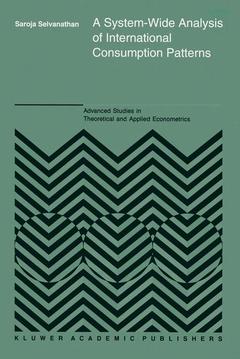Description
A System-Wide Analysis of International Consumption Patterns, Softcover reprint of the original 1st ed. 1993
Advanced Studies in Theoretical and Applied Econometrics Series, Vol. 29
Author: Selvanathan S.
Language: English
Subjects for A System-Wide Analysis of International Consumption Patterns:
Keywords
Approximative price 210.99 €
In Print (Delivery period: 15 days).
Add to cart
Publication date: 11-2012
342 p. · 16x24 cm · Paperback
342 p. · 16x24 cm · Paperback
Description
/li>Contents
/li>
The modern system-wide approach to applied demand analysis emphasizes a unity between theory and applications. Its fIrm foundations in economic theory make it one of the most impressive areas of applied econometrics. This book presents a large number of applications of recent innovations in the area. The database used consist of about 18 annual observations for 10 commodities in 18 OECO countries (more than 3,100 data points). Such a large body of data should provide convincing evidence, one way or the other, about the validity of consumption theory. A PREVIEW OF THE BOOK The overall importance of the analysis presented in the book can be seen from the following table which shows the signifIcant contribution of the OECO to the world economy. As can be seen, the 24 member countries account for about 50 percent of world GOP in 1975. In this book we present an extensive analysis of the consumption patterns of the OECO countries.
1: Introduction.- 1.1 The System-Wide Approach to Consumption Economics.- 1.2 Two Examples.- 1.3 More on the Linear Expenditure System.- 1.4 Recent Innovations in the System-Wide Approach.- 1.5 International Consumption Comparisons.- 1.6 Some International Consumption Data.- 1.7 Indexes of International Consumption Data.- 1.8 Some Results from the LPW Study.- 1.9 The Rotterdam Model.- 1.10 Working’s Model.- 1.11 Working’s Model and Differential Demand Equations.- 1.12 Further Evidence on Working’s Model.- 1.13 A Demand System for the World.- 1.14 The Comparability of International Data.- 1.15 Policy Implications.- Appendix to Chapter 1.- References.- 2: Empirical Regularities in OECD Consumption.- 2.1 Introduction.- 2.2 The OECD Database.- 2.3 Budget Shares and Price and Quantity Log-changes.- 2.4 Divisia Moments.- 2.5 Relative Prices and Consumption.- 2.6 Double-Log Demand Equations.- 2.7 A Bird’s Eye View of the Elasticities.- 2.8 Is there a Relationship Between the Price and Income Elasticities?.- 2.9 The Relationship Between the Autonomous Trends and Income and Price Elasticities.- 2.10 A Nonparametric Picture of Prices and Quantities.- 2.11 More on the Nonparametric Picture.- Appendices to Chapter 2.- References.- 3: Do OECD Consumers Obey Demand Theory?.- 3.1 Introduction.- 3.2 The Demand Model.- 3.3 Demand Homogeneity.- 3.4 Slutsky Symmetry.- 3.5 Theil’s Monte Carlo Test.- 3.6 Specifying the Covariance Matrix.- 3.7 The Performance of Alternative Specifications of ?.- 3.8 Monte Carlo Testing of Homogeneity for the OECD.- 3.9 Monte Carlo Testing of Symmetry for the OECD.- 3.10 Monte Carlo Testing of Preference Independence for the OECD.- 3.11 The Implied Demand Elasticities.- 3.12 More on the Elasticities.- 3.13 Concluding Comments.- Appendices toChapter 3.- References.- 4: How Similar Are OECD Consumers?.- 4.1 Introduction.- 4.2 Model I: A Demand System for Each of the 15 Countries.- 4.3 Model II: Common Demand Parameters.- 4.4 Model III: A Formally Pooled Demand System.- 4.5 Model IV: Theil’s Cross-Country Demand System.- 4.6 Comparison of the Models.- 4.7 More on the Comparison.- 4.8 Do the Demand Parameters Depend on Income and Prices?.- 4.9 Concluding Comments.- Appendices to Chapter 4.- References.- 5:The Reliability of ML Estimators of Systems of Demand Equations.- 5.1 Introduction.- 5.2 The Estimates.- 5.3 The Simulation Procedure.- 5.4 The Simulation Results for Seven Countries with the Usual Covariance Matrix.- 5.5 The Simulation Results for Eighteen Countries with the Alternative Covariance Matrix.- 5.6 The Simulation Results for the Pooled Model.- 5.7 Concluding Comments.- Appendices to Chapter 5.- References.- 6: Further Evidence on the Frisch Conjecture.- 6.1 Introduction.- 6.2 Estimating the Income Flexibility.- 6.3 322 Estimates of the Income Flexibility.- 6.4 A Constant Income Flexibility for Each Country.- 6.5 Testing Frisch’s Conjecture.- 6.6 Comparison with Other Studies.- 6.7 Concluding Comments.- Appendices to Chapter 6.- References.
© 2024 LAVOISIER S.A.S.




